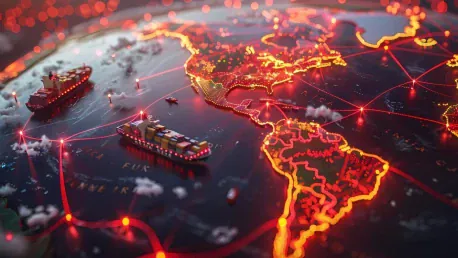The Europe maritime information market is on a robust growth trajectory, reflecting the increasing reliance on advanced technological solutions to enhance maritime operations. With satellite-based Automatic Identification Systems (AIS), Geographic Information Systems (GIS), and Internet of Things (IoT) sensors revolutionizing maritime data, the market’s evolution is evident. Valued at USD 464 million in 2024, it is projected to grow at a CAGR of 5.68%, reaching USD 762 million by 2033. This growth is driven by rising global trade volumes, stringent regulatory frameworks, and the necessity for maritime safety and security.
Economic Impact and Employment
Significant Economic Contribution
The maritime sector undeniably plays a crucial role in the EU economy, contributing approximately €500 billion annually. This substantial contribution represents over 2% of the EU’s GDP, underscoring the economic significance of maritime activities and operations within the region. The vital infusion into the economy from the maritime sector not only illustrates its importance but also highlights its potential for future expansion and further economic contributions amid evolving technological advancements.
Employment Opportunities
In addition to its profound economic contribution, the maritime sector employs more than 4 million people across Europe, providing a broad spectrum of job opportunities. These roles range from seafarers navigating the ships to port operators managing logistics and coordination at bustling international ports. Moreover, the maritime sector’s employment potential extends beyond direct jobs, indirectly supporting ancillary industries such as shipbuilding, marine services, and supply chain logistics. As the sector grows and adopts advanced technologies, the demand for skilled professionals in new technological fields will likely rise, further boosting employment opportunities and fostering economic stability across the continent.
Regulatory and Safety Needs
Increasing Demand for Accurate Information
The increasing need for accurate maritime information is primarily driven by stringent regulatory requirements and concerns over illegal fishing, piracy, and environmental protection. Accurate maritime data is paramount in dealing with these concerns effectively, highlighting the necessity for sophisticated data solutions. The European Union has seen rising incidents of maritime risks, further stressing the importance of reliable information for ensuring navigational safety and eco-friendly maritime operations. Therefore, the integration of high-end maritime information systems and real-time data monitoring becomes indispensable in alleviating these regulatory and safety challenges, aligning with Europe’s comprehensive maritime security goals.
Role of European Maritime Safety Agency
The European Maritime Safety Agency (EMSA) underscores the importance of maritime information by revealing that over 90% of Europe’s external trade relies on maritime transport. This staggering percentage highlights the sector’s critical role in facilitating international commerce and the pressing need for enhanced maritime data solutions to ensure safety, security, and regulatory compliance. EMSA’s continuous efforts in enhancing maritime safety through surveillance, monitoring, and risk assessment further consolidate the need for advanced, reliable, and accurate maritime information systems to support this essential industry’s seamless and secure operation.
Technological Advancements
Adoption of Advanced Technologies
The adoption of AI-driven analytics, IoT, satellite-based Automatic Identification Systems (AIS), and Geographic Information Systems (GIS) is on the rise within the maritime sector. These advanced technologies are vital for enhancing operational efficiency, enabling better decision-making, and supporting sustainable maritime practices. By leveraging AI and machine learning, maritime companies can optimize routes, reduce fuel consumption, and predict potential mechanical issues before they occur. IoT sensors provide real-time data on vessel performance and environmental conditions, helping operators monitor and maintain optimal conditions for safety and efficiency. Satellite-based AIS and GIS offer precise real-time tracking and mapping of maritime movements, crucial for navigation, collision avoidance, and strategic planning.
Digitalization Initiatives
Digitalization initiatives, such as the EU’s Blue Economy Strategy, are instrumental in driving the adoption of these advanced technologies across the maritime sector. These initiatives aim to foster innovation, efficiency, and sustainable practices by integrating digital solutions into maritime operations. The EU’s Blue Economy Strategy focuses on leveraging digital technologies to promote sustainable growth in the maritime and marine sectors, aligning with Europe’s Green Deal objectives. By embracing digitalization, maritime operators can improve resource management, enhance operational transparency, and reduce environmental impact, all while adhering to regulatory frameworks designed to protect marine ecosystems. Such initiatives are not merely about adopting new technologies; they are about embedding digital transformation at the core of maritime operations for long-term, sustainable success.
Market Drivers
Ensuring Maritime Safety and Security
Ensuring maritime safety is a primary driver of market growth, as human errors contribute to over 80% of maritime accidents. The reliance on data-driven systems to mitigate these risks is becoming increasingly prominent, with maritime operators investing heavily in technologies that can enhance situational awareness and operational safety. Advanced maritime information systems, including AI-driven analytics, predictive maintenance tools, and automated navigation aids, enable better decision-making and risk management. By leveraging these technologies, operators can significantly reduce the likelihood of accidents, ensuring safer, more secure maritime operations across European waters and beyond.
Investments in Surveillance Technologies
Governments and maritime organizations are making substantial investments in surveillance technologies like AIS and radar systems to enhance situational awareness and security. These investments aim to combat issues like smuggling, piracy, and other maritime threats by providing real-time data and monitoring capabilities. Enhanced surveillance technologies not only help in tracking vessel movements and activities but also play a crucial role in emergency response and incident management. By improving the overall visibility of maritime operations, these technologies contribute to a safer and more secure maritime environment, supporting the growth and stability of the maritime sector.
Global Trade and Port Digitalization
As maritime transport facilitates 74% of goods entering or leaving the EU, the digital transformation of ports becomes essential for streamlining logistics and improving efficiency. Smart port technologies, including automated cargo handling systems, real-time tracking, and predictive analytics, are being increasingly employed to optimize operations and reduce vessel turnaround times. By integrating these technologies, ports can significantly enhance their operational capabilities, minimize delays, and reduce emissions, contributing to a more sustainable and efficient maritime transport system. The digitalization of ports is not just about adopting new technologies; it’s about transforming the entire logistics chain to support the growing demands of global trade and ensure the seamless movement of goods across borders.
Market Restraints
High Implementation Costs
The high costs associated with deploying advanced maritime information systems act as significant barriers to their widespread adoption, particularly for smaller ports and operators. Initial investments in these systems can exceed €10 million per port, posing substantial financial challenges for entities with limited budgets. The comprehensive nature of these systems, which often include AI-driven analytics, IoT sensors, and real-time monitoring tools, requires significant capital expenditure and ongoing maintenance costs. Smaller maritime entities may struggle to justify these investments, leading to disparities in technological adoption and operational efficiency across the sector. Addressing these cost barriers through innovative financing solutions and public-private partnerships will be crucial in fostering more inclusive technological adoption across the maritime industry.
Cybersecurity and Data Privacy Concerns
With the increasing reliance on digital technologies, the frequency of cyberattacks targeting maritime infrastructure has also risen, posing significant challenges for the industry. Additionally, strict GDPR regulations compound these challenges by requiring robust data protection measures, which can be both complex and costly to implement. Nearly 55% of maritime stakeholders consider cybersecurity risks a significant barrier to adopting advanced information systems, highlighting the need for comprehensive cybersecurity strategies. Protecting sensitive maritime data from cyber threats and ensuring compliance with data privacy regulations require investments in advanced security measures, staff training, and continuous monitoring. The industry must prioritize cybersecurity to safeguard critical infrastructure and maintain the integrity and reliability of maritime operations.
Market Opportunities
AI and Predictive Analytics
AI-driven solutions and predictive analytics present substantial opportunities for the maritime sector, offering ways to optimize route planning, reduce fuel consumption, and enhance safety. By analyzing vast amounts of data from various sources, AI can provide insights into optimal routes, weather conditions, and potential hazards, enabling more informed decision-making. Predictive analytics can also identify maintenance needs before failures occur, minimizing downtime and improving operational efficiency. These technologies not only enhance safety and efficiency but also contribute to sustainability by reducing the environmental impact of maritime operations. As the industry continues to embrace digital transformation, the integration of AI and predictive analytics will play a pivotal role in driving innovation and competitive advantage.
Blue Economy Initiatives
The expansion of Europe’s blue economy, contributing around €650 billion annually to the EU GDP, offers vast opportunities for growth and innovation. Investments in sustainable projects, advanced ocean data services, and new maritime ventures support various sectors, including aquaculture, renewable energy, and coastal tourism. These initiatives align with the EU’s Green Deal objectives, promoting sustainable use of marine resources and reducing the environmental impact of maritime activities. By leveraging advanced technologies and data-driven solutions, the blue economy can drive economic growth while preserving marine ecosystems and ensuring long-term sustainability. The development of innovative, eco-friendly maritime practices and the integration of digital technologies will be key to realizing the full potential of the blue economy and achieving a sustainable future for the maritime industry.
Market Challenges
Fragmentation of Data Systems
Inconsistent data standards and interoperability issues continue to hinder seamless information sharing across the maritime sector. Nearly 40% of maritime stakeholders face integration challenges due to fragmented systems, leading to inefficiencies in logistics, surveillance, and overall operational management. The lack of standardized data protocols and the prevalence of incompatible systems create significant barriers to achieving a unified maritime information ecosystem. Addressing these challenges requires collaborative efforts to establish common data standards and integrate disparate systems, ensuring smooth data flow and enhancing the overall efficiency of maritime operations. Industry-wide initiatives and partnerships will be crucial in overcoming these integration hurdles and fostering a more cohesive and efficient maritime information network.
Environmental and Regulatory Pressures
Adhering to stringent environmental regulations is both challenging and expensive for maritime operators, imposing financial and operational burdens. The need for real-time environmental monitoring and compliance with regulations like the International Maritime Organization’s (IMO) sulfur cap requires substantial investments in advanced technologies and sustainable practices. These regulatory pressures necessitate continuous monitoring and reporting, adding to the operational complexities and costs. Maritime operators must balance the need for regulatory compliance with the financial constraints of implementing necessary technologies and practices. Innovative solutions and strategic investments in eco-friendly technologies will be essential in navigating these regulatory challenges and ensuring sustainable maritime operations.
Future Outlook
Technological Innovations
The future growth of the European maritime information market heavily relies on technological advancements, particularly in AI, predictive analytics, and IoT. These innovations are expected to significantly transform maritime operations, enhancing efficiency, safety, and sustainability. By leveraging these advanced technologies, maritime operators can streamline processes, optimize resource utilization, and minimize environmental impact. The continuous evolution and adoption of these technologies will drive future market development, enabling operators to meet the growing demands of global trade and regulatory compliance. The industry’s commitment to embracing innovation will be key to achieving long-term growth and competitiveness in the rapidly evolving maritime landscape.
Alignment with Sustainability Goals
The fusion of digitalization with sustainable practices underscores the current market trend, aligning with broader economic and environmental goals such as the EU Green Deal. This alignment is crucial for future growth, as the maritime industry seeks to balance technological advancements with sustainable development. By integrating digital solutions and eco-friendly practices, the industry can achieve operational efficiency while minimizing environmental impact. The focus on sustainability will drive investments in innovative solutions that support the green transition, ensuring that the maritime sector contributes to a healthier planet while maintaining economic prosperity. This dual emphasis on technology and sustainability will shape the future trajectory of the maritime market, positioning it as a key player in the global effort to combat climate change and promote sustainable development.
Addressing Challenges
The European maritime information market is experiencing significant growth, underscoring the increasing dependence on advanced technology to improve maritime operations. This market is being transformed by satellite-based Automatic Identification Systems (AIS), Geographic Information Systems (GIS), and Internet of Things (IoT) sensors, which are revolutionizing maritime data collection and analysis. By 2024, the market is expected to be valued at USD 464 million and is projected to grow at a Compound Annual Growth Rate (CAGR) of 5.68%, achieving a valuation of USD 762 million by 2033.
Several factors are driving this growth. First, the volume of global trade continues to rise, necessitating more efficient and secure maritime operations. Second, increasingly stringent regulatory frameworks require more sophisticated monitoring and reporting systems to ensure compliance. Finally, the overarching necessity for enhanced maritime safety and security plays a crucial role. By adopting these advanced technological solutions, the maritime industry can better manage vessel traffic, mitigate risks, and improve overall operational efficiency.
In summary, the European maritime information market is poised for significant expansion due to the integration of cutting-edge technologies and the pressing need for enhanced safety and regulatory compliance in maritime activities.









